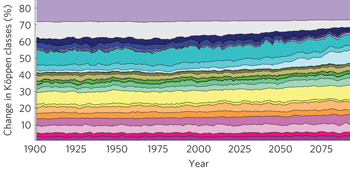Pace of climate zone shifts quickens as climate warms
Pace of climate zone shifts quickens as climate warms
According to a new study co-authored by Susan Solomon, as the planet warms, not only do Earth's climate zones keep shifting, they actually shift at an accelerating pace giving species inhabiting each zone less time to adapt.
 "The warmer climate gets, the faster the climate zones are shifting. This could make it harder for plants and animals to adjust," said lead author Irina Mahlstein.
"The warmer climate gets, the faster the climate zones are shifting. This could make it harder for plants and animals to adjust," said lead author Irina Mahlstein.
The study is the first to look at the accelerating pace of the shifting of climate zones, which are areas of the Earth defined by annual and seasonal cycles of temperature and precipitation, as well as temperature and precipitation thresholds of plant species. Over 30 different climate zones are found on Earth; examples include the equatorial monsoonal zone, the polar tundra zone, and cold arid desert zone.
"A shift in the climate zone is probably a better measure of 'reality' for living systems, more so than changing temperature by a degree or precipitation by a centimeter," said Mahlstein.
The scientists used climate model simulations and a well-known ecosystem classification scheme to look at the shifts between climate zones over a two-century period, 1900 to 2098. The team found that for the initial 2 ° Celsius (3.6 ° Fahrenheit) of warming, about 5 percent of Earth's land area shifts to a new climate zone. The models show that the pace of change quickens for the next 2 ° Celsius of warming, and an additional 10 percent of the land area shifts to a new climate zone. "Pace of shifts in climate regions increases with global temperature" was published online in the journal Nature Climate Change on April 21.
Certain regions of the globe, such as northern middle and high latitudes, will undergo more changes than other regions, such as the tropics, the scientists found. In the tropics, mountainous regions will experience bigger changes than their surrounding low-altitude areas.
In the coming century, the findings suggest that frost climates – the coldest climate zone of the planet – are largely decreasing. Generally, dry regions in different areas of the globe are increasing, and a large fraction of land area is changing from cool summers to hot summers.
The scientists also investigated whether temperature or precipitation made the greater impact on how much of the land area changed zones. "We found that temperature is the main factor, at least through the end of this century," said Mahlstein.
This story is adapted from a news article at esrl.noaa.gov.